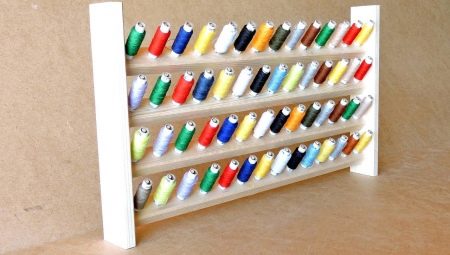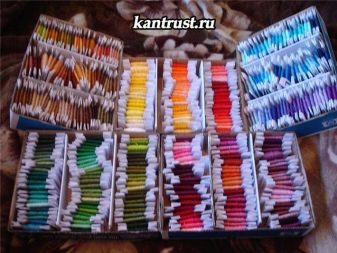All about thread organizers

Even beginner needlewomen very quickly face the question of storing their stocks. For sewing operations, threads are needed not only of different shades, but also of different thickness and composition. What can we say about those who sew or embroider for many years. To put all this in order, many use various boxes, special organizers. If you choose the right container for threads, then they will be stored in order, they will not get confused with each other. And the ability to see all the colors at once will not only facilitate the work, but also speed it up a lot. After all, order at the workplace of a needlewoman is the key to successful work and excellent mood.

Advantages and disadvantages
Each organizer has its positive and negative sides.... For example, the main advantage of ready-made structures is not only in their appearance, but also in the ability to combine them in various combinations.
Homemade organizers have the advantages of being able to take into account all the nuances of the work of an individual needlewoman and low cost. But at the same time, their production takes time, materials, while many options still look very handicraft.

Species overview
Various accessories can be used to store the threads. Whether they are purchased or home-made - the whole variety of organizers for storing sewing accessories can be roughly divided into several types:
- plastic boxes, boxes;
- plywood, cardboard boxes;
- caskets, chests of drawers made of wood;
- regular glass or plastic jars;
- tin boxes;
- wall shelves;
- various baskets and much more.



The main purpose of any organizer is to organize your sewing or embroidery threads and avoid tangling.
Handicraft manufacturers have taken care of this. There are not only different bobbins available. They can be of the usual cylindrical shape (of different heights, diameters), in the form of a flat figure with special notches and stops (ears, bones, etc.). You can buy ready-made kits with threads placed on bobbins, or you can wind it yourself, adjusting the required amount of the desired color.


Most often, plastic containers are produced with dividers. This allows you to adjust the size of the cells for a certain number of bobbins. Plastic organizers for storing sewing accessories are popular due to their combination of low price and durability. But the appearance of such organizers usually leaves much to be desired. You can use regular organizers for small items for the thread wrapped around the bones. Fishing boxes are especially suitable for this purpose.

Reels from the manufacturer are usually accompanied by special labels with a color number, manufacturer's indication and other useful information. In addition, some flat bobbins have special holes that allow them to be stored in special folders on rings or separate carabiners. This method is convenient for matching the threads to a specific job, allowing you to separate only the spools that are currently needed.

Small spools, leftover thread can be stored in regular jars with a wide neck... This is one of the simplest and most affordable options. In a transparent jar, you can clearly see what is in it. The rich colors can be used as interior decoration. Still, this method is rather chaotic and impractical.

The wall organizer is convenient in that the whole range of threads is perfectly visible on it, it is easier to track their number.
The most common are two options for such designs: an open stand with shelves or a board with pins that can be installed vertically, horizontally, or at a slight angle. Such stands look equally aesthetically pleasing. The only negative - on an open stand, the threads are exposed to unfavorable factors (excessive humidity or dryness, temperature changes) and can become dirty from dust. Such stands can be purchased in specialized stores or made on your own.


The hanging organizer, in contrast to the stand, is convenient in that it can be moved to a convenient place. Plastic and fabric options are available for sale. Samples with small transparent pockets are very convenient. This allows you to divide the threads into the necessary categories and see the entire assortment available. You can search for them not only in handicraft stores, most often such organizers are sold in household or children's trade pavilions. Another advantage of hanging organizers is the ability to organize storage not only on the walls of the workshop, but also inside the cabinets.


Apart from all this variety, there are special boxes for needlework. They not only serve for practical purposes for storing sewing accessories, but are also a pleasant interior decoration. Conventionally, boxes for needlework are divided into three types: in the form of a box with handles (often resembling a basket, inside which there are many moving parts with cells or mini-shelves), in the form of a wooden chest (less often made of plywood, plastic), which is covered with cloth or pasted over with paper , film.
The boxes look original in the form of a suitcase with a textile or leather case and metal fittings.


If the space of the room allows, then the purchase or manufacture of a special organizer cabinet can be an ideal solution. A well-thought-out space allows you to store in it not only all stocks of thread, but also other handicraft accessories (needles, scissors, elastic bands, small cuts of fabric, canvas, etc.). A purchased cabinet can always be converted to fit your needs, optimizing all free space.

How to do it yourself?
If it is not possible to purchase an organizer for threads that suits all parameters, then you can always make it yourself. For this, any master class you like from the ones below can be suitable.
From a plastic bottle
An excellent basis for such an organizer will be a bottle of suitable volume with a square base. Peeled and dried, it is cut into two equal parts vertically to the bottom, which it is desirable to leave intact. To do this, you can use a hot knife.
In the open workpiece, places are marked for holes, the distance between which should be slightly larger than the diameter of the filled bobbin. With a red-hot knitting needle, a hot gun or a soldering iron, you need to make holes (diameter 0.5-1 cm) into which you can thread wooden skewers of suitable length or cocktail tubes. The spools of thread are strung on these sticks.



If you wish, you can make small holes opposite each bobbin to bring the thread out. Through these holes, you can thread the ends of the threads so that you can unwind the required amount without unnecessary movements.
After that, you can connect both parts of the bottle and close the lid. A simple and inexpensive quick organizer is ready.


Out of a cardboard box
Cardboard organizers, of course, are not durable. But they are easy to make, which is why they are the most common. If you wish, you can make a number of the same type of organizers and decorate them in the same style.
It is best to take a shoebox with a removable lid for this variation. To do this, the lower part of the box must be cut in height so that the bobbin of the selected size fits vertically into it. It is advisable to immediately glue the cut edges with paper or masking tape in order to avoid shedding.
You can use thinner cardboard or craft paper folded several times as spacers. To do this, cut strips of the required length (width and length of the box from the inside) and interconnect crosswise. The size of the mesh should be equal to the diameter of the thread bobbin.
Or you can simply fill the space inside the box with cut-off toilet paper or paper towel sleeves. In this case, you can store several threads of the same color in one cell.




You can choose another option. A piece of foam or cork board is placed at the bottom of the cardboard box, into which small pins are stuck (the height is slightly more than the height of the reel itself). If desired, the pins can be glued with heavy-duty glue. The distance between them should be such that adjacent bobbins do not dangle, but can be easily removed.
At the final stage of making a cardboard organizer for threads, it is advisable to glue it over with paper, you can make decoupage using beautiful pictures.
In any case, there are many options, the decoration of the product is limited only by the imagination of the craftswoman.

From a tin box
The organizer from a can of candy or cookies will become more durable. The simplest manufacturing option is laying foam plastic with wooden pins on the bottom of a can. To make a more durable structure, holes are made in the base according to a pre-marked pattern. Then metal bolts of a suitable height are screwed into them. If desired, the finished work can be decorated in various ways. For example, paint with special paints or decorate using decoupage technique.




How to make a thread organizer from a shoe box, see below.








